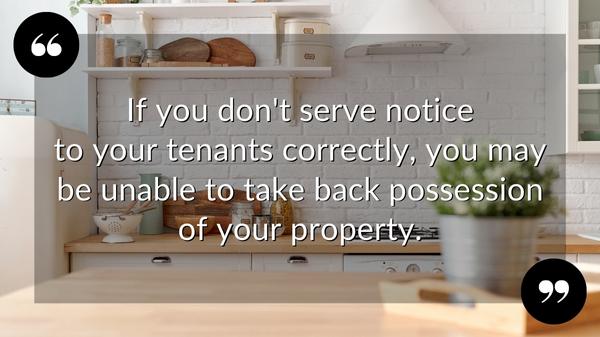Your tenants have moved in, you’ve protected their deposit, and the first month’s rent is in the bank. So what comes next?

Following on from Part One of our Landlord Lingo Buster, Part Two is all about effective management to keep everything running smoothly, legally and profitably.
Regular inspections, health & safety laws, claiming all your tax allowances and reviewing the performance of your investment are the foundations of being a successful landlord, while serving notice the right way is essential for getting your property back when you want to.
There’s a lot to get through, and whether you’re a landlord in the Wilton & Salisbury area or elsewhere in the UK, our jargon buster is here to ramp up your knowledge and boost your confidence. So without further ado, let’s dive in!
MID-TENANCY CHECKS
As well as health and safety laws to stick to after your tenants move in, you should also make regular visits to your property during the tenancy. These are called Periodic Inspections, and they’re essential for spotting potential problems early, building relationships with your tenants and, if they’re leaving, seeing if there’s anything you need to prepare or repair for viewings.

A successful mid-tenancy check procedure includes the following:
- Periodic inspection clause
To have the right to access your property during the tenancy, you must include a clause within the tenancy agreement.
- Inspection checklist
Take a checklist with you to ensure you don’t miss anything - the Landlord Vision website is excellent.
- Inspection report
After your visit, it’s good practice to send a report to your tenants with your findings, including any actions they need to take and anything you intend to repair.
Even if you’re entitled to inspect your rental property, you must give your tenants at least 24 hours’ notice, and you cannot enter without their consent. The inspection also needs to be at a reasonable time of day, which means no spontaneous midnight visits after a curry!
SUCCESSFUL RENT REVIEWS
Rent reviews can be a touchy subject, particularly with the rising cost of living. But a rent review isn’t only about rent; it’s also about keeping your property competitive with the local market as a sustainable investment. A typical process includes:

- Annual rent check
A good managing agent will review your property every year and advise on whether or not the rent should rise, using evidence of nearby comparable homes. They should also suggest any upgrades to help you increase the popularity, performance and longevity of your investment.
- Section 13 notice (England & Wales)
In England and Wales, if you wish to increase the rent, the initial Assured Shorthold Tenancy term must have ended, and you must serve your tenants with a Section 13 notice at least one month before the rent is due to rise. Some tenancy agreements include a rent increase clause in which case it is not necessary to serve a Section 13 notice.
Of course, not all landlords increase rents to their maximum level every year, particularly if they have great tenants they want to keep. At the same time, most tenants accept that rents do go up, and realistic increases are generally not seen as unfair and are far less hassle and costly than moving home again.
UNDERSTANDING YIELDS & GROWTH
You should keep a regular eye on the ongoing performance of your rental property to get the most from your investment. But although gross yields are usually quoted in adverts, the figures to focus on when projecting income and profit are net yield and capital growth.

- Gross yield
The gross yield is the annual rent expressed as a percentage of the purchase price. For instance, a £100,000 property rented at £5,000 per year produces a gross yield of 5%. This tends to increase over time as rents rise.
- Net yield
This figure tells you the real profit of your rental property, because it considers all your costs, like mortgages, maintenance, fees and repairs, before working out the percentage. Simply deduct these from your income, and divide the remainder by the purchase price.
- Capital growth
As a property increases in value, the capital growth is the amount the price increases expressed as a percentage. A price increase from £100,000 to £110,000 represents 10% capital growth, and landlords often use this extra equity to fund the deposit on another rental property.
It’s good practice to review the yield of your rental property every year, and to check if there’s anything you can do to improve its performance.
TAX TALK
Tax legislation for lettings has changed quite a bit in the last few years, and it’s left some landlords, and would-be investors confused about what expenses they can and can’t claim. So here’s a quick rundown of the things you need to know:

- Tax relief
Since 2020, the amount you can claim back against any mortgage secured on your rental property is fixed at 20% of the interest payments.
- Allowable expenses
The costs you can deduct from your income on your tax return, including repairs, safety checks, agents’ & accountants’ fees, references and inventories - check the full list on the gov.uk website.
- Capital expenses
Improvements and upgrades to your rental property (including modernisation and major renovations) are classed as capital expenses and are not tax deductible.
When improvements are incidental to a repair, the lines can blur because they often qualify as an allowable expense. Examples include replacing a broken single-glazed window with a double-glazed unit, and like-for-like replacements of baths, wash basins and toilets.
GETTING YOUR PROPERTY BACK
If you want to regain possession of your rental property, getting the paperwork right is essential to minimise the risk of complications and delays. There are different ways of serving notice depending on where your rental property is in the UK, and these include:

- Section 21 notice (England & Wales)
You can serve a Section 21 notice (also known as a ‘no fault notice’) anytime after either the end of the initial fixed term or the break clause date. At least two months’ notice is required, and you must have protected the security deposit.
- Section 8 notice (England & Wales)
If you have a legal reason to end a tenancy, like serious rent arrears, damage or illegal behaviour, you can serve a section 8 notice at any time. The notice period is just 14 days.
- Accelerated Procedure for evictions (England & Wales)
If your tenants refuse to leave, you may need to start the eviction process, which can be lengthy and costly. However, with a Section 21 notice, and if you’re not claiming any rent arrears, you can apply for an Accelerated Procedure, which doesn’t require a court hearing.
To avoid being invalidated, your notice must include your tenant’s name(s), the full address of the property and the date the notice period ends, and all spelt correctly. You must also have supplied your tenants with a tenancy agreement and valid safety certificates. Many landlords come unstuck when serving notice, so if you’re unsure how to proceed, do get in touch.
Do you have any questions about landlord lingo?
We’re here to answer any questions about being a landlord in the Wilton & Salisbury area, so why not get in touch? Call us on 01722 580059 or drop us a line at info@piccoloproperty.co.uk for some friendly, expert advice.
And in case you missed it, you can read part one of our landlord lingo buster here which covers all the steps in getting your property let and setting your tenancy up the right way.






Share this with
Email
Facebook
Messenger
Twitter
Pinterest
LinkedIn
Copy this link